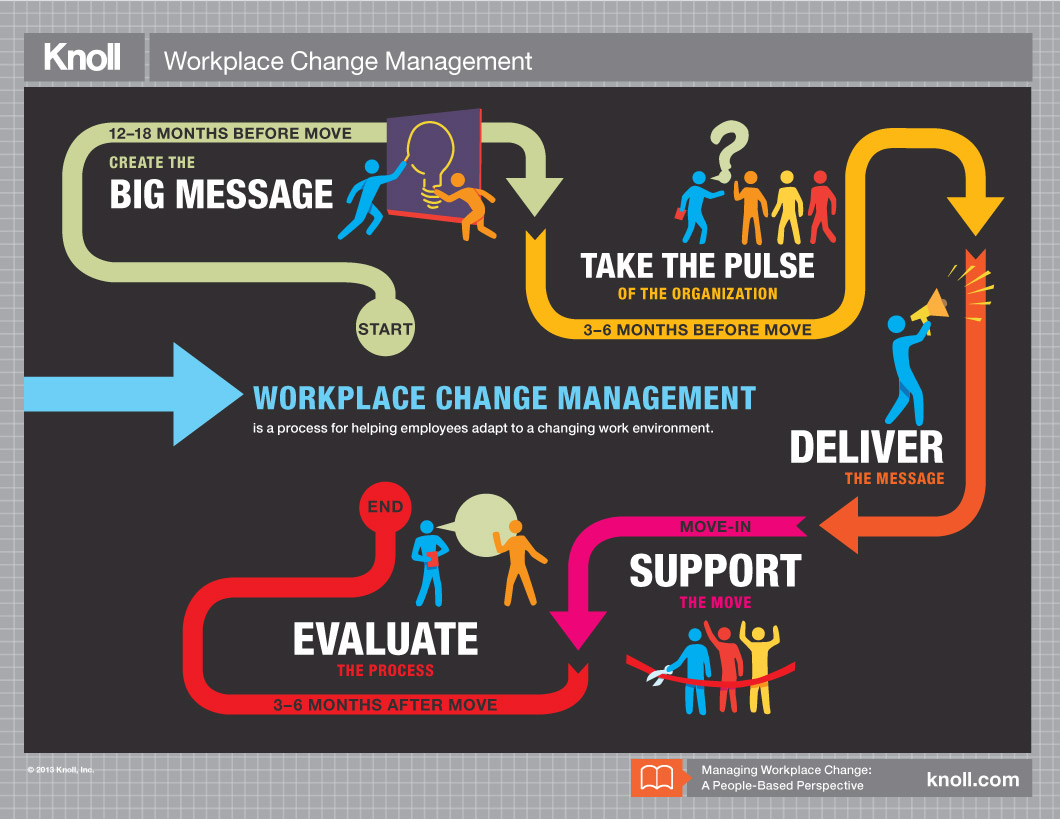12 reasons employees resist change [infographic]
I always find it interesting that the reasons for resistance to change are so well known (even people who aren't change management experts have a good intuitive understanding of the reasons for change resistance, based on their own life experience), and yet so often unaddressed in the workplace.
So here's an infographic about the reasons for change resistance and some ideas for how to guide against resistance. It's all about communication, leadership, employee engagement and, of course, taking the time to listen.
(infographic by Catherine Adenle at Catherine's Career Corner)

More than words can say: Communication that will help your career
In my opinion, the single biggest determining factor in whether a change initiative is successful or not is communication. Communication across the leadership team, communication from leadership to managers and employees – and communication from people on the front lines back to management.
The challenge is that good communication is never a one-way street: It requires that everyone in the chain has good communication skills, from the most junior intern right up to the C-suite heavy-hitters.
You may not be able to change everyone in your organization, but you might be surprised to find that improving your own communication skills can have a positive effect on those around you. Here are some tips:

Communication tips for everyone, no matter what their role in the organization:
- Be respectful
- Be a great listener (and acknowledge that you’re listening)
- Remember that communication is two-way (listen and respond)
- Speak so others can hear you (put it in terms your audience will understand and appreciate)
Tips for Recipients (individual contributors):
- Ask questions to get the information you need
- Communicate as positively with peers as with those above you
- Speak so others can hear you (and pay attention to the channel they respond to best)
- Listen so others will want to talk to you
Tips for Translators (supervisors/managers):
- Listen – so your employees will talk to you
- Take information from above and convey it clearly to those below you
- Use positive communication to build teams (both the one you manage and the management team you’re part of)
- Don’t overload your team – be concise, not overwhelming
- Learn to ‘hear between the lines’
- Understand company direction and help your staff understand it
Tips for Synthesizers (directors/vice-presidents):
- Listen for clarity from above
- Listen with compassion from below
- Synthesize information into a ‘narrative’ or ‘story’ that helps you move your teams toward their goals
- Use the right filter for what you’re hearing (understand the subtext)
- Communicate so your boss will hear you (be strategic)
- Communicate so employees will want to listen to you (be engaging)
- Communicate to strengthen alliances with your peers (be a valued source of insight)
Sounds simple when it’s here in bullet points, doesn’t it? But great communication really requires reflection and a conscious effort to understand the person (or people) to whom you’re communicating – it’s really about getting in the habit of making that effort on a day-to-day basis.
Making change communication compelling
On my more or less constant quest for interesting change management items, I came across this infographic today:

Now, Knoll is a company which specializes in office furniture (or perhaps they'd prefer to call it 'workplace environment design'), so their core competency isn't change management. However, if you're a supplier involved in a refit of an office of hundreds or thousands of people, you're going to need to know something about change management - because no matter how beautiful your 'office environments' are, getting a whole lot of people packed up, moved and settled, without losing a lot of productivity, requires quite a lot of change to be managed.
This content of this particular infographic isn't particularly earth-shattering - communication, input, messaging, supporting and evaluating are all pretty standard components of any change initiative - but what I liked about it was how aethetically pleasing it is, and how it makes clear that even an office move requires a 12-18 month lead time in terms of communicating the Big Idea to the organization. In my experience, if organizations did a better job of creating compelling communications, and put them in place earlier in the change process, almost every change initiative would go a heck of a lot more smoothly and with more enthusiastic buy-in throughout the process. After all, it's hard for people to keep resisting something that looks so appealing, especially if it's been announced months - or years - in advance.
Just something to think about.
Four change management books (I think) you should read
If you're like me, you probably have a stack of business books somewhere in the corner of your office, just waiting for the mythical day (or month) when you have nothing else to do but read. Except that when you finally make some time, you discover that most of those books have one or two good points, buried in a whole lot of stuff you already knew or which isn't all that relevant to your day-to-day working life.
That's why, when Bruno Gebarski asked me the other day for my recommendations on great change management books, I didn't have to think too hard about my choices. There are lots of business change management books out there, but only a handful that I read cover to cover, and refer to and reference often in my work. If you don't have time to read any other change management books this year, these will give you lots to work with.
Aftershock: Helping People Through Corporate Change
by Harry Woodward & Steve Buchholz

This is my all-time favorite book about change, and in many ways it's the first book which really addressed the issues around what happens to the people in an organization when they're faced with huge changes. Even though it was written in 1987, the points the authors make about how to manage people through change are still relevant today, and I find myself referring to Woodward & Buchholz's principles time and again. If you want to understand - and I mean really understand - the people side of change, this is the book for you.
Leading Change
by John P. Kotter

Of course, you can't talk about change management writers without talking about John Kotter. He's been one of the leading voices in the field for years now. I have to admit that I'm not the most passionate devotee of Kotter, but I really like this book because it speaks the language of business. I can reference it with my clients - some of whom are familiar with Kotter already, from conferences or workshops - and they understand immediately. I also use his concept of a 'guiding coalition' (making sure you have a team comprised of people with the right amount of power, expertise, credibility and leadership) on all my projects - it's one of those practical tips that make a huge difference no matter what kind of change initiative you're undertaking.
Managing Transitions: Making the Most of Change
by William Bridges

First published in 1995, this book is now in its 3rd edition, which gives you some idea of just how useful it must be. It's designed for employees and managers, to help them get through change by understanding, accepting and even embracing the new status quo. Not every change fits into the 'transition' category, but I find the model particularly useful in cases where the change initiative has potentially negative implications for individuals. I also use it when I work with my executive coaching clients - we don't go step-by-step through Bridges' model, but I use the principles to help clients who are in that space between 'endings' and 'beginnings'.
ChangeSmart: Implementing Change Without Lowering Your Bottom Line
by Beth Banks Cohn

What would this list be without a shameless plug for one of my own books? Written for middle- and higher-level managers, this book is all about leveraging the power of your employees to help a change go more smoothly and productively, and with the best possible effect on the bottom line of the organization. It's got a field-tested framework that can be applied to almost any business project plan, has real-life examples, and, best of all, it can be read in under 2 hours!
What about you? Which change-related books have been most influential in your day-to-day work? (Share your recommendations on Twitter @BethBanksCohn.)
Why Does Change Management Sound So Boring?
Ideas are great. Implementation is better.
Here's an idea: I'll give you 3 job titles, and you choose the one you'd most like to have.
Change Agent
Innovation Catalyst
Change Management Consultant
You didn't choose Change Management Consultant, did you?

Somehow, 'Change Agent' and anything with the word 'innovation' in it sound a lot more exciting than 'Change Management'. And yet, in many ways, change management is the most important part of the process.
Last week I met a fellow whose business card said he was a 'Change Agent'. He was everything you'd expect someone with that title to be: 30-something, fashionable clothes, great sunglasses and full of information about the latest hot topics on TechCrunch and Mashable.
Of course, I'm always interested in anything to do with 'change', so I started asking him what he did on a day-to-day basis. "Oh, you know," he said. "I inject ideas into the organizational framework and help us transform the marketplace."
He did have some interesting ideas - he's definitely thinking about where his industry will be in the next 5-10 years, and how the market will change in that time. That kind of thinking is important for any organization.
But between Big Ideas and Big Results there is...implementation. And that's where Change Management comes in. The problem is that 'management' never seems that exciting - especially compared with 'injecting ideas'.
That's why I like to think in terms of architecture. Architects take someone else's Big Idea - "I want a beautiful house on this piece of land" - and then figure out how to make the big picture work wtih the small details to get it done. They show you the model of the building with the graceful facade - and then they show you the detailed construction plans which outline how the thing is going to be built. And then a good architect oversees the process, from the first groundbreaking to the final landscape design.
There's no question that there's something inherently exciting about coming up with a brand new idea for change - it's like starting a new notebook with nothing but possibilities ahead. But in the long run there's something much more satisfying about being able to take an idea from conception to fruition to results that being an 'agent' or 'catalyst' just can't touch.
When change falls flat
People view change in different ways, and some are more resistant to change than others. Even if you believe the change you've just announced is positive, beneficial on many levels, and an easy sell, there will be employees who react negatively.
Even employees who are highly resilient may not embrace change if you fail to:
- prepare them,
- communicate with them along the way, and proactively
- manage the change process.
When the change you've announced falls flat and you're met with resistance, it's probably a sign that you've made some missteps in preparing and presenting the initiative upfront. If this is the case, don’t panic. All is not lost.
Here are some general guidelines on how to win over the “resistors”:
Get to the bottom of the negative reaction.
Listen to your employees. Give them a nonthreatening forum in which to express their misgivings, fears, and struggles with the change you are proposing. Make sure you understand the nature of their negative reaction and what might be driving it. For example, they don't understand their new role, don't agree with the timing, or perhaps are just reacting to the "surprise" factor. Engaging in this discovery process with employees helps you and your team develop targeted implementation strategies. Equally important, it lets the resistors know that you're listening.
Communicate what you've learned.
Answer all negative responses in future communications. Address each of the issues they brought up in straightforward, clear language. When appropriate, take responsibility for missteps. For instance, if some employees are reacting negatively because you announced the change without adequate warning, admit your mistake and move on. Get employees involved in the forward momentum of the change process. Instead of dwelling on their resistance, get them focusing on where they can go from here — and how you will do it together.
Emphasize the positive.
Continue to be upbeat, and emphasize the potential good in the change. Winning over resistors involves helping them identify aspects of the change they can feel good about. For example, let them know which aspects of their job are changing and which are remaining stable. Point out how the changes will benefit them. Explain new opportunities and fresh possibilities. Above all, reassure them that they will receive ample resources and support necessary to navigate through turbulent times.
Be realistic about potential negatives.
Doctors have learned that when they inform patients ahead of time what to expect, their patients react better to pain. The same is true for employees. Don't minimize the challenges that are going to be a necessary side effect of the proposed change. Instead, prepare them for various contingencies. When employees know there may be lean times, for example, or a steep learning curve ahead, they will be better prepared. Moreover, "telling it like it is" shows respect on your part.
Engage your middle managers.
Think of middle managers as the eyes and ears of the change process. Ask them to check in with employees early and often during the process to ensure that everyone understands their new role, has a clear sense of organizational objectives, and has the resources to do what's expected of them. Have them regularly report back to you what they've learned. Resistance will continue to pop up along the way, but most negative reactions can be avoided or easily averted through frequent, accurate communication and consistent messaging — much of it by middle managers.
When change falls flat, take heart. You may not be able to undo the initial damage you caused by not preparing your employees well enough, but you will be able to win over resistors and make the change process smoother and more successful from this stage forward.
INFOGRAPHIC: Managing Big Hairy Projects
I do sometimes enjoy a great infographic - it's amazing how a different format can sometimes help you to see information in a whole new way.
Today I noticed an interesting infographic from OneSpring about managing big projects, and thought I'd share it.
Remember you can follow me on Twitter at @BethBanksCohn!


